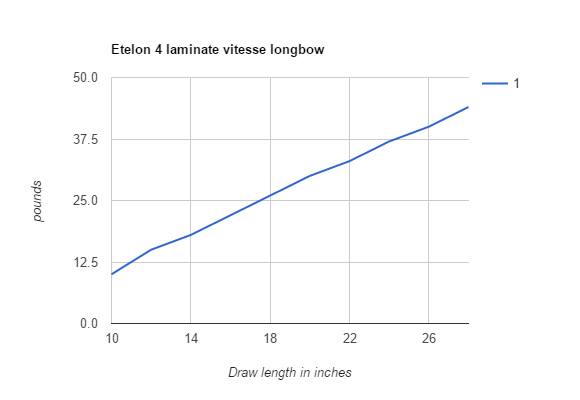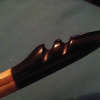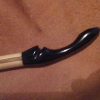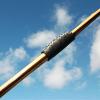Our aim is to produce high quality longbows of exceptional performance
From the high performance of our Bamboo back bows to the reenactment bow, we aim to deliver smooth fast shock free shooting.
Our bows are tillered to a very high standard using every inch of the bow to spread the load. Materials are carefully selected to produce extremely reliable bows and finished to our demanding standard using an oil varnish blend ( Danish oil) or similar long oil varnish. Bows are inspected after each coat for flaws which are rectified before the next coat of oil is applied, normally at least ten coats are required to produce an exceptional flexible finish.
We use the best material available to produce fast and durable longbows
Bow backing that is good under tension we use two main types
Hickory offer an excellent choice
Bamboo produces very fast bows
Bow belly woods that are excellent under compression
Lemonwood is an excellent choice, very resistant to compression fractures, recommended for bows up to 60lbs
It has now become very scarce as they have stopped cutting due to numbers.
Ipe is very dense suitable for high performance bows and those over 60lbs. Limbs can be reduced in weight especially on higher poundages. This is selected to be without the smallest flaw. We reject 50% as unsuitable.
Core woods that provide tension and speed.
Purpleheart, Greenheart, Ipe, Hickory ,very wide choice of others.
Bow backing that is good under tension we use two main types
Hickory offer an excellent choice
Bamboo produces very fast bows
Bow belly woods that are excellent under compression
Lemonwood is an excellent choice, very resistant to compression fractures, recommended for bows up to 60lbs
It has now become very scarce as they have stopped cutting due to numbers.
Ipe is very dense suitable for high performance bows and those over 60lbs. Limbs can be reduced in weight especially on higher poundages. This is selected to be without the smallest flaw. We reject 50% as unsuitable.
Core woods that provide tension and speed.
Purpleheart, Greenheart, Ipe, Hickory ,very wide choice of others.
The length of bow is very important and makes a massive difference to the speed of the bow. A longer bow will have less stacking, the poundage from BH to full draw will be closer together, the limbs will be longer so heavier, which slows the bow down. Shorter bows are faster, limbs are slimmer, the difference from BH to full draw will be greater. So its important to buy a bow that is suitable for its purpose. An indoor bow at short range then a longer bow may be the most suitable. For longer distance then medium length of bow would be suitable. A 50lbs x 28 max DL; The range of length within reason can be from 67" between cut string nocks to 72" So for most people 69" to 71" would give a good sensible compromise between speed and smoothness. This depends on material and poundage of the bow, so just a crude guideline used as an example.
Tiller we use three types, mainly type 1 and 2
Our type 1 tiller or full compass: The bow bends throughout its length including handle to form a perfect arc as if described by a compass. This is based on the medieval longbow and ideal for more speed, very reliable as the compression and tension are less, as it is shared throughout the bow.
Our type 2 tiller is an improved version of the traditional Victorian target Longbow: The bow describes an arc but a minimal area at the grip remains stiff.
Tillering Explained
Material is removed from the belly in areas where the bow is too stiff to produce a smooth arc or desired shape when the bow is fully drawn. This is primarily done to prevent one area of the bow being over strained and breaking but also gives the bow its speed and character.
If a bow bends more in near the string Nocks it increases the poundage, because the lever is shorter the bow will be relatively easy to draw from brace height, the last few inches very difficult. The bow will be "stacking". A bow made like this will requires less expenditure of energy overall, but will have less stored energy.
If the limbs remain as long as possible the difference from the start of the Draw to full draw will be less. You will have more stored energy. Recurve bows exploit this where one part shortens while the re-curve lengthens as it is drawn.
Tiller we use three types, mainly type 1 and 2
Our type 1 tiller or full compass: The bow bends throughout its length including handle to form a perfect arc as if described by a compass. This is based on the medieval longbow and ideal for more speed, very reliable as the compression and tension are less, as it is shared throughout the bow.
Our type 2 tiller is an improved version of the traditional Victorian target Longbow: The bow describes an arc but a minimal area at the grip remains stiff.
Our type 3 is a full compass bow but up to the last 6" the last six inches remain stiff to reduce stacking. This would only be used on bows over 76" bows need to be made longer for the same DL. Some shorter bows may benefit if a long draw-length is not required. It brings the shape of the bow closer to a Recurve, but the extra length and weight can outweighs any advantage gained.
Tillering Explained
Material is removed from the belly in areas where the bow is too stiff to produce a smooth arc or desired shape when the bow is fully drawn. This is primarily done to prevent one area of the bow being over strained and breaking but also gives the bow its speed and character.
If a bow bends more in near the string Nocks it increases the poundage, because the lever is shorter the bow will be relatively easy to draw from brace height, the last few inches very difficult. The bow will be "stacking". A bow made like this will requires less expenditure of energy overall, but will have less stored energy.
If the limbs remain as long as possible the difference from the start of the Draw to full draw will be less. You will have more stored energy. Recurve bows exploit this where one part shortens while the re-curve lengthens as it is drawn.



